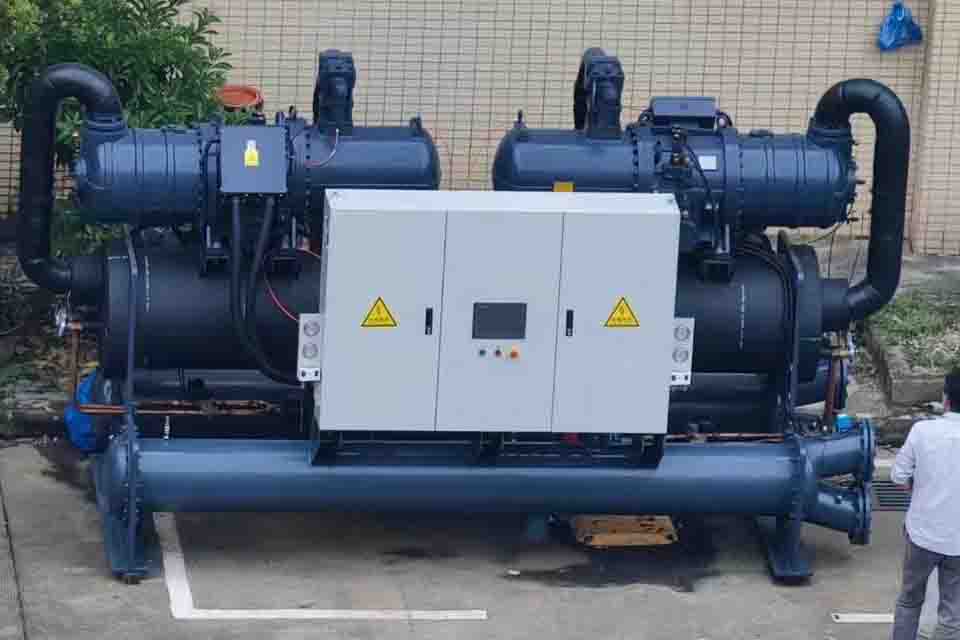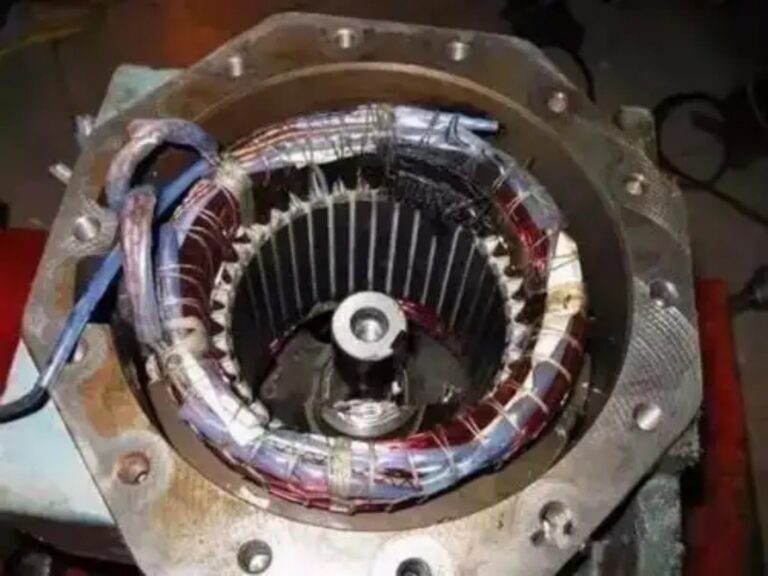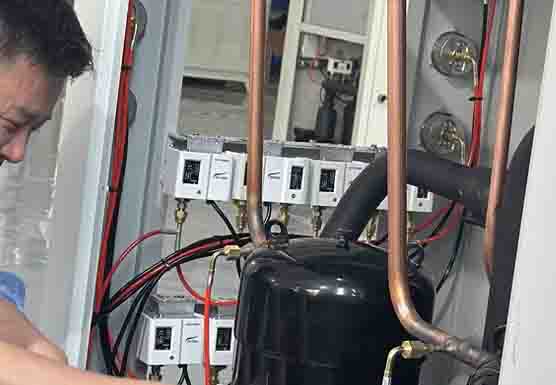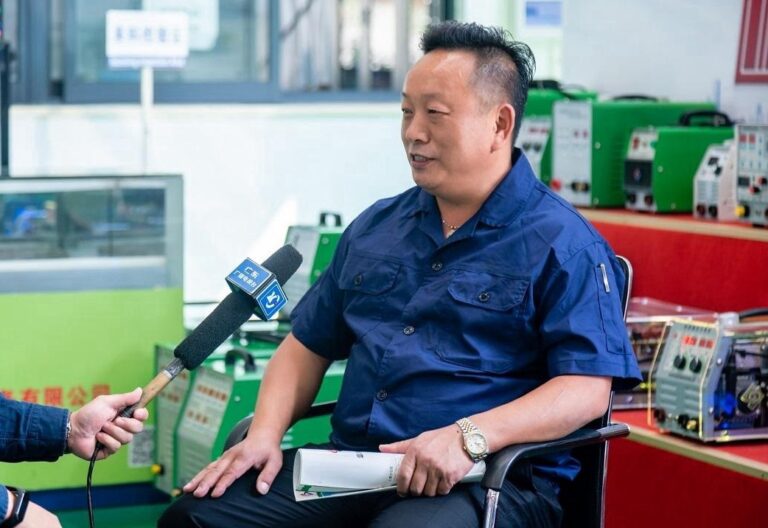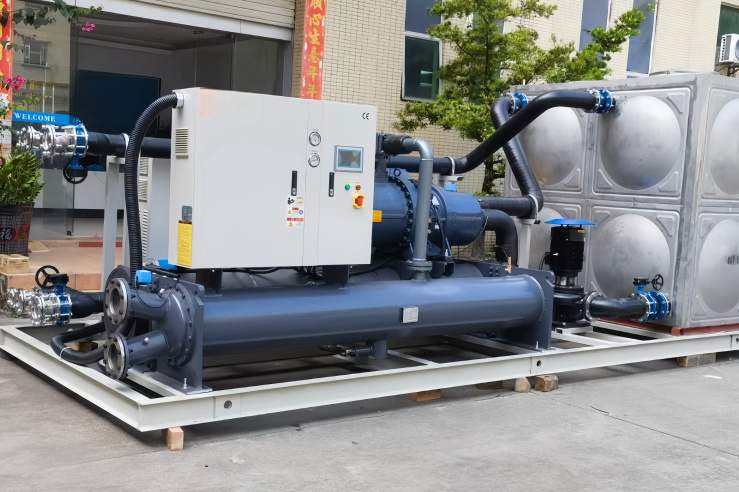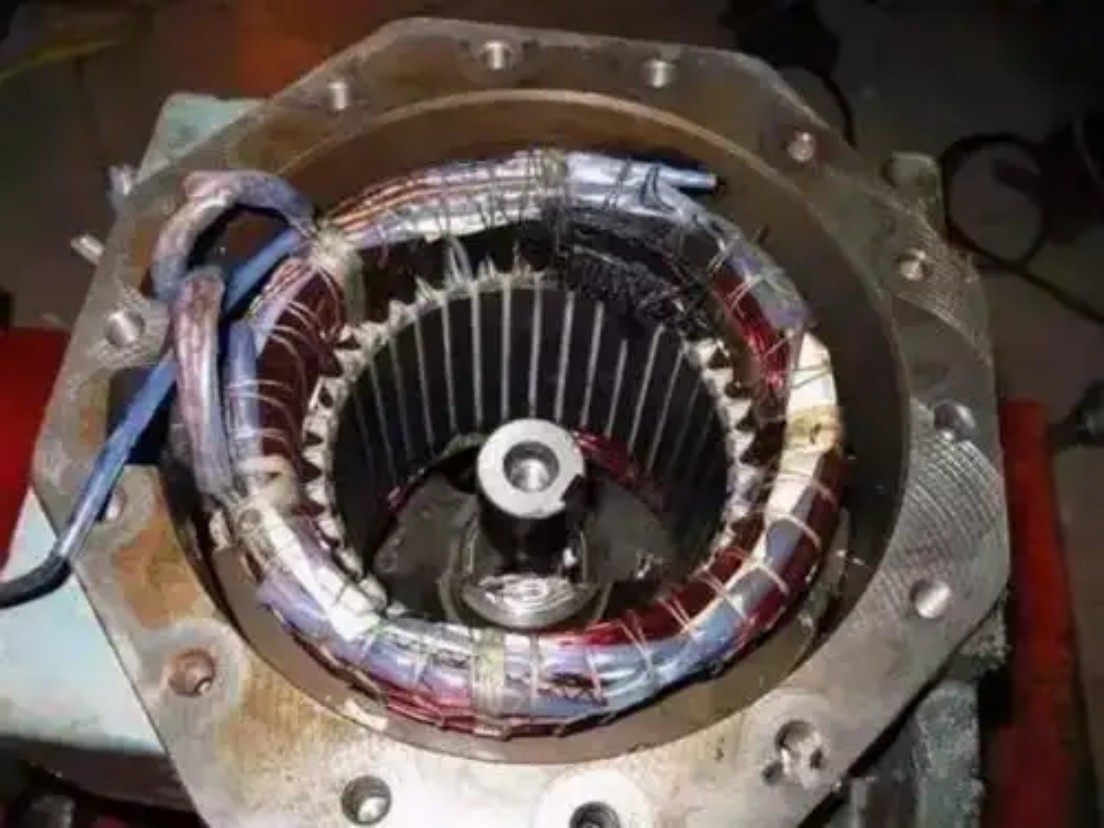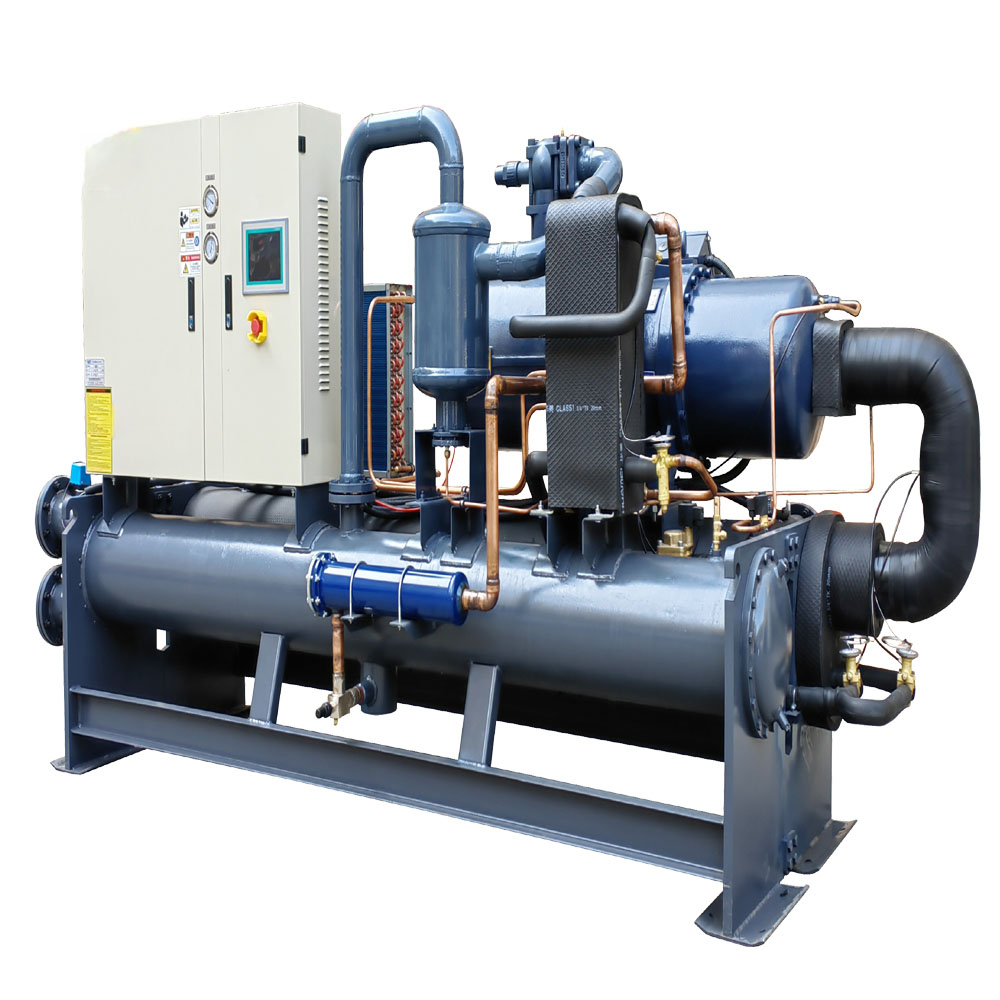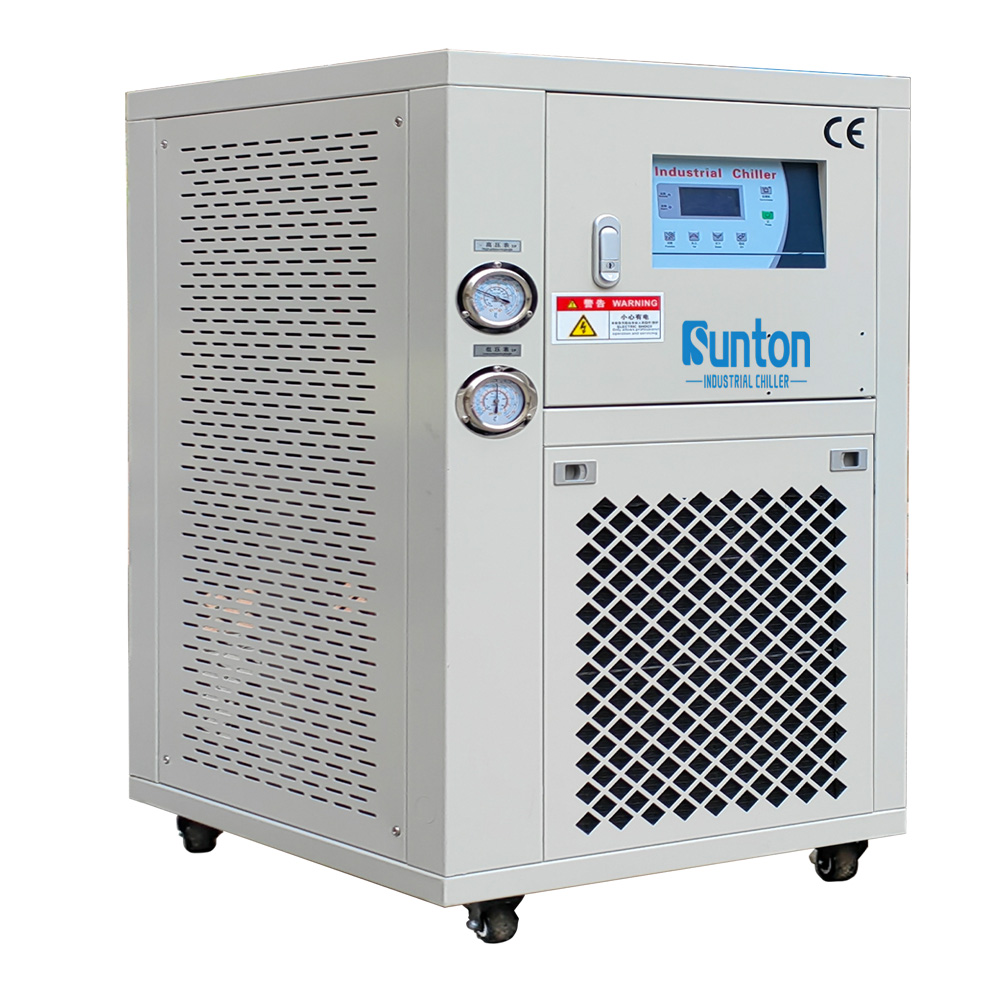-
달링산 산업 광동
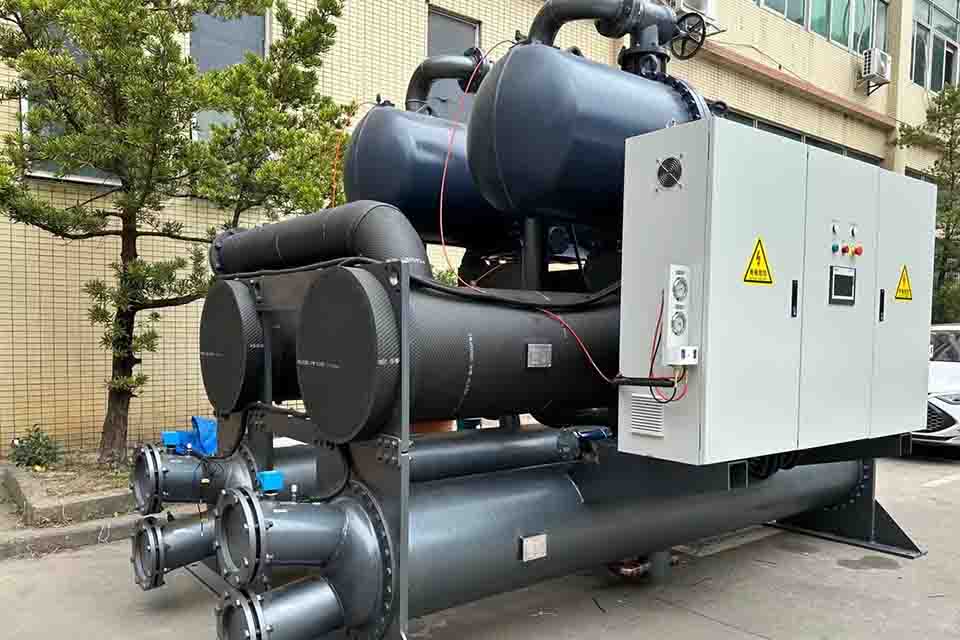
물 냉각기 크기 조절 방법
산업용 수냉 애플리케이션을 위한 냉각기 크기를 계산하는 방법
이 문서에서는 다음 방법에 대한 포괄적인 가이드를 제공합니다. 냉각기 크기 계산 다양한 산업용 수냉 응용 분야에 적합합니다. 올바른 냉각기 크기를 이해하는 것은 효율적이고 효과적인 냉각을 보장하고 시스템 과부하를 방지하며 에너지 소비를 최적화하는 데 중요합니다. 플라스틱 및 고무 산업, 기계 가공 산업 또는 데이터 센터에 종사하든 이 문서는 엔지니어가 아니더라도 이해하기 쉬운 과정을 안내합니다. 정보에 입각한 결정을 내리고, 비용이 많이 드는 실수를 피하고, 냉각 시스템이 최고의 성능으로 작동하도록 하는 데 도움이 되므로 읽어볼 가치가 있습니다. 산업용 수냉기 제조 공장으로서, 우리는 올바른 제품을 선택하는 데 필요한 지식을 제공하고자 합니다. 산업용 냉각기 귀하의 특정 요구 사항에 맞게.
목차
1. 냉각기란 무엇이고 올바른 크기가 중요한 이유는 무엇입니까?
A 냉각기 증기 압축 또는 흡수 냉각 사이클을 통해 액체에서 열을 제거하는 기계입니다. 이 액체는 열교환기를 통해 순환하여 장비 또는 다른 공정 스트림(예: 공기 또는 공정수)을 냉각할 수 있습니다. 산업 환경에서 냉각기 최적의 작동 온도를 유지하고, 제품 품질을 보장하고, 장비 손상을 방지하는 데 필수적입니다. 냉각기 플라스틱, 고무, 기계 가공, 식품, 음료, 화학, 제약 등 다양한 산업에서 광범위하게 사용됩니다.
올바른 크기를 선택하는 것의 중요성 냉각기 과장할 수 없습니다. 크기가 작음 냉각기 항상 문제가 될 것입니다. 공정 장비를 제대로 냉각할 수 없어 효율성이 떨어지고 마모가 증가하고 잠재적인 가동 중단이 발생합니다. 반면에 대형 냉각기, 충분한 냉각을 제공할 수 있지만 비효율적으로 작동하여 더 높은 에너지 소비와 증가된 운영 비용으로 이어질 것입니다. 목표는 다음을 찾는 것입니다. 이상적인 냉각기 크기 이를 통해 시스템이 가장 효율적으로 실행 수준을 높여 에너지 사용량은 최소화하고 성능은 극대화합니다.
2. 온도 차이(ΔT°F)는 어떻게 계산합니까?
온도차이, 로 표시됨 ΔT°화씨, 올바른 것을 결정하는 데 중요한 요소입니다. 냉각기 크기. 그것은 사이의 차이를 나타냅니다 유입수온 그리고 원하는 물 배출구 온도. 온도 차이를 계산하다, 당신은 필요합니다 물의 온도를 확인하세요 에서 입구 그리고 콘센트 의 냉각기. 덜다 의 물 배출구 온도에서 유입수온 을 얻으려면 ΔT°화씨.
예를 들어, 유입수온 60°F이고 원하는 온도입니다. 물 배출구 온도는 50°F입니다. ΔT°화씨 10°F(60°F - 50°F = 10°F)가 됩니다. 온도 변화 그것은 무엇인가 냉각기 달성해야 합니다. 더 큰 ΔT°화씨 는 것을 나타냅니다 냉각기 더 열심히 일해야 해 물을 식히다, 더 큰 것이 필요할 수 있음 냉각기 용량정확하게 하는 것이 중요합니다 온도 차이를 계산하다 왜냐하면 그것이 직접적으로 영향을 미치기 때문입니다 사이징 공식 그리고 올바른 것을 결정하는 데 도움이 됩니다. 필요한 냉각기 크기.
3. 냉각기 크기에서 유량의 역할은 무엇입니까?
일반적으로 측정되는 유량 속도 분당 갤런 (지피엠(GPM)), 또 다른 필수 요소는 결정입니다. 필요한 냉각기 크기. 분당 냉각해야 하는 물의 양을 나타냅니다. 유량은 공정에서 제거해야 하는 열의 양과 직접 관련이 있습니다. 유량을 결정하려면 다음을 사용할 수 있습니다. 유량계 또는 소요되는 시간을 기준으로 계산합니다. 물 배출구 용량을 알고 있는 용기를 채우는 선.
예를 들어, 5갤런 용기를 채우는 데 2분이 걸린다면 흐름 속도는 2.5가 됩니다. 지피엠(GPM) (5갤런/2분 = 2.5 지피엠(GPM)). 유량을 정확하게 측정하는 것은 유량이 사용되기 때문에 매우 중요합니다. 사이징 공식 에게 믿다 필요한 것 냉각기 용량. 더 높은 유량은 분당 더 많은 물을 냉각해야 한다는 것을 의미하며, 이는 더 큰 용량이 필요할 수 있습니다. 냉각기. 유량을 올바르게 결정하면 다음이 보장됩니다. 냉각기 냉각 부하를 효율적으로 처리할 수 있습니다.
4. BTU를 사용하여 냉각기 용량을 계산하는 방법은 무엇입니까?
영국 열량 단위 (열량(BTU))는 열에너지의 측정 단위입니다. 하나 열량 열량은 상승하는 데 필요한 열량입니다. 물의 온도 1파운드의 물을 1도 화씨. 맥락에서 냉각기 사이즈, 열량(BTU) 공정에서 제거해야 할 열의 양을 정량화하는 데 사용됩니다. 믿다 필요한 것 냉각기 용량 in 열량(BTU), 유량을 알아야 합니다. 온도차이 (ΔT°화씨), 그리고 물의 비열.
계산 공식 시간당 BTU 이다:
시간당 BTU = 유량(지피엠(GPM)) * ΔT°화씨 * 물의 비열 * 물의 밀도
물의 경우 비열은 1이다. 당 BTU 화씨 1도당 파운드이고 밀도는 갤런당 약 8.33파운드입니다. 따라서 공식은 다음과 같이 간소화됩니다.
시간당 BTU = 유량(지피엠(GPM)) * ΔT°화씨 * 1 * 8.33
예를 들어, 유량이 10인 경우 지피엠(GPM) 그리고 ΔT°화씨 화씨 10도입니다 시간당 BTU 다음과 같을 것입니다:
시간당 BTU = 10 지피엠(GPM) * 화씨 10도 * 8.33 = 8330 시간당 BTU
이 계산은 원하는 냉방을 달성하기 위해 시간당 얼마나 많은 열을 제거해야 하는지를 알려줍니다.
5. 냉각기 톤수는 무엇이며 냉각 용량과 어떤 관련이 있습니까?
냉각기 톤수 냉각 용량을 나타내는 측정 단위입니다. 냉각기. 1톤의 냉각 용량은 12,000에 해당합니다 시간당 BTU. 즉, 1-톤 칠러 12,000을 제거할 수 있습니다 열량(BTU) 시간당 열량. 냉각기 톤수 대용량 냉각 용량을 표현하는 편리한 방법입니다. 냉각기 산업용으로 사용됨.
변환하려면 시간당 BTU 에게 냉각의 톤, 당신은 나누어요 시간당 BTU 12,000으로. 이전 섹션의 예를 사용하여 8330을 계산했습니다. 시간당 BTU:
엄청난 냉각 = 8330 시간당 BTU / 12,000 = 0.69 톤
이는 다음을 의미합니다. 냉각기 약 0.69의 용량 톤 냉각 부하를 처리하려면 필요합니다. 이해 냉각기 톤수 올바른 것을 선택하는 데 중요합니다 사이즈 칠러 귀하의 신청서에.
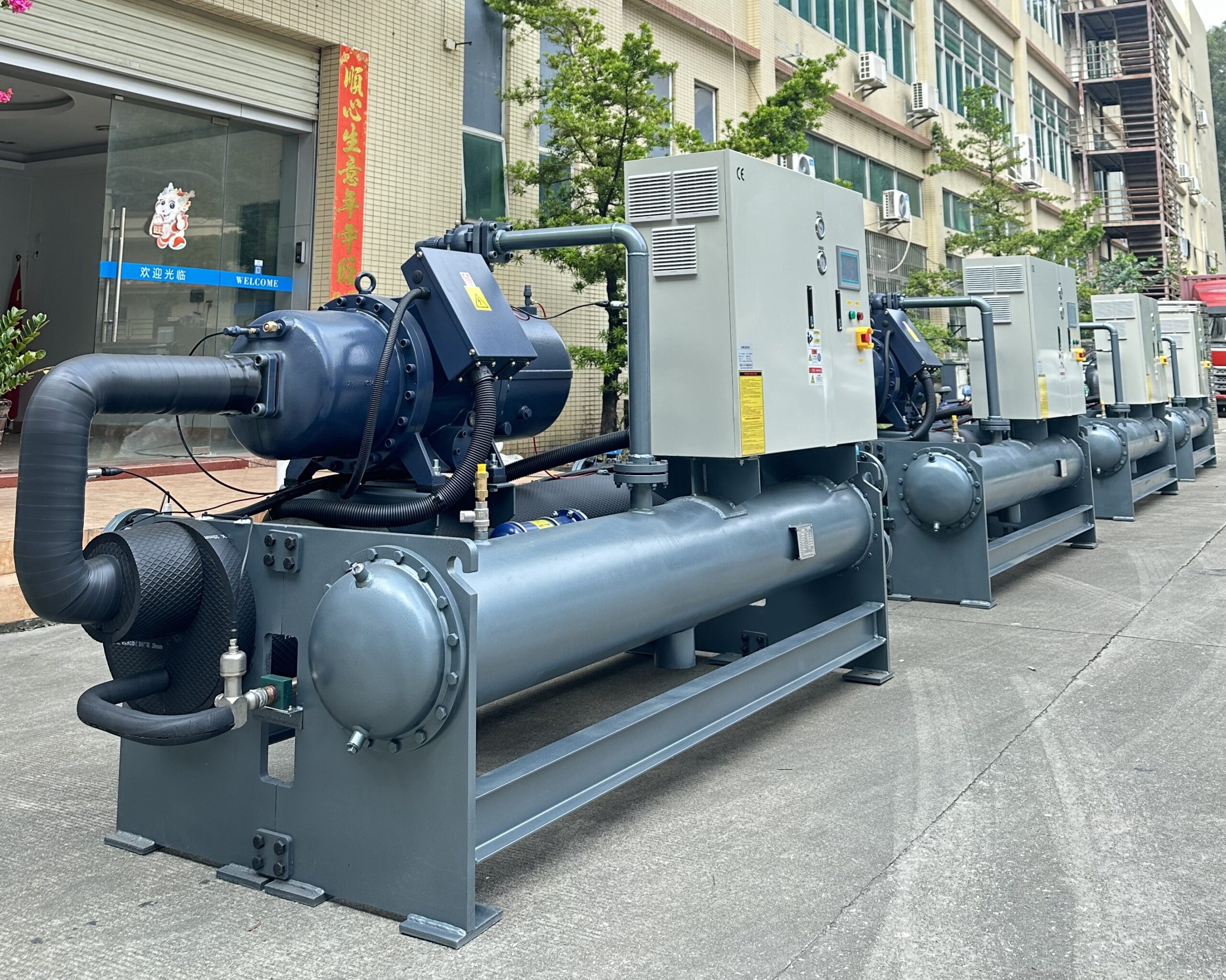
6. 냉각기 크기 공식을 사용하여 이상적인 크기를 결정하는 방법은 무엇입니까?
그리고 사이징 공식 결정하는 데 중요한 도구입니다. 이상적인 크기 의 냉각기 귀하의 특정 응용 프로그램을 위해. 이 공식은 유량, 온도차이 (ΔT°화씨), 그리고 안전 계수 믿다 필요한 것 냉각기 용량. 기본 사이징 공식 이다:
냉각기 용량(톤) = (유량(지피엠(GPM)) * ΔT°화씨 * 8.33) / 12,000
예를 들어, 유량이 20인 경우 지피엠(GPM) 그리고 ΔT°화씨 화씨 15도입니다 냉각기 용량 다음과 같을 것입니다:
냉각기 용량(톤) = (20 지피엠(GPM) * 화씨 15도 * 8.33) / 12,000 = 0.208 톤
그러나 작동 조건의 변화와 향후 냉각 수요 증가 가능성을 고려하기 위해 안전 계수를 추가하는 것이 중요합니다. 일반적인 안전 계수는 20%이므로 조정된 냉각기 용량 다음과 같을 것입니다:
조정됨 냉각기 용량(톤) = 0.208 톤 * 1.20 = 0.2496 톤
이는 다음을 의미합니다. 냉각기 용량은 약 0.25 톤 필요할 것입니다.
7. 냉각기 크기가 너무 작거나 너무 크면 어떤 결과가 초래됩니까?
안 크기가 작은 냉각기 항상 문제가 될 것입니다. 공정 장비를 제대로 냉각할 수 없습니다. 이로 인해 효율성이 떨어지고 마모가 증가하고 잠재적으로 가동이 중단될 수 있습니다. 냉각기는 절대로 안될거야 원하는 것을 달성하다 물의 온도, 장비가 과열되고 잠재적으로 오작동합니다. 플라스틱 및 고무와 같은 산업에서는 이로 인해 제품 결함과 출력 감소가 발생할 수 있습니다. 기계 가공 산업에서는 공구 손상과 정밀도 저하로 이어질 수 있습니다.
반면에, 대형 냉각기, 충분한 냉각을 제공할 수 있지만 비효율적으로 작동합니다. 자주 켜지고 꺼져서 에너지 소비가 증가하고 운영 비용이 증가합니다. 게다가 대형 냉각기 온도 변동을 일으킬 수 있으며, 이는 화학 및 제약 산업과 같이 정밀한 온도 제어가 중요한 산업에 해로울 수 있습니다. 찾기 이상적인 냉각기 크기 최적의 성능과 비용 효율성을 위해서는 필수적입니다. 크기가 작은 냉각기는 항상 냉각 수요를 따라가기 위해 고군분투하는 동안 대형 냉각기 당신을 이끌 것입니다 다른 크기의 장치를 구매하세요 필요 이상으로 사용하면 에너지와 돈이 낭비됩니다.
8. 냉각기 크기에 대한 업계별 고려 사항은 무엇입니까?
산업별 요구 사항은 올바른 것을 결정하는 데 중요한 역할을 합니다. 사이즈 칠러 귀하의 애플리케이션을 위해. 다양한 산업은 프로세스, 장비 및 운영 조건에 따라 고유한 냉각 요구 사항을 가지고 있습니다. 다음은 몇 가지 예입니다.
- 플라스틱 및 고무 산업: 이 산업에서는 성형 및 압출 공정 중에 발생하는 열로 인해 높은 냉각 용량이 필요한 경우가 많습니다. 냉각기 최적의 제품 품질을 위해 급격한 온도 변화를 처리하고 정확한 온도 제어가 필요합니다.
- 기계가공 산업: 가공에서, 냉각기 절삭유를 냉각하고 공구 과열을 방지하는 데 사용됩니다. 냉각기의 크기 기계의 크기, 가공하는 재료의 종류, 절삭 속도에 따라 달라집니다.
- 식품 및 음료 산업: 이 산업에서는 사용합니다 냉각기 냉각 재료, 발효 온도 제어, 음료 냉각 등 다양한 용도로 사용됩니다. 냉각기 크기 처리되는 제품의 양과 필요한 냉각 속도에 따라 달라집니다.
- 화학 및 제약 산업: 이러한 산업에서는 화학 반응과 민감한 물질의 보관을 위해 정밀한 온도 제어가 필요한 경우가 많습니다. 냉각기 특정 온도 범위를 유지하고 제품 품질 저하를 방지하려면 크기를 정확하게 조절해야 합니다.
- 데이터 센터: 냉각기 서버를 냉각하고 과열을 방지하는 데 중요한 역할을 합니다. 냉각기 크기 서버 수, 열 출력, 데이터 센터의 원하는 작동 온도에 따라 달라집니다.
이것들을 이해하다 산업별 올바른 것을 선택하려면 고려 사항이 중요합니다. 사이즈 칠러 귀하의 특정 요구 사항을 충족합니다.
9. 냉각기 선택을 위한 모범 사례는 무엇입니까?
오른쪽 선택 냉각기 여러 가지가 포함됩니다 모범 사례 최적의 성능과 효율성을 보장하기 위해:
- 냉방 부하를 정확하게 계산: 사용하세요 사이징 공식 그리고 유량과 같은 모든 관련 요소를 고려합니다. 온도차이및 산업별 요구사항.
- 안전 계수 추가: 약 20%의 안전 계수를 추가하여 작동 조건의 변화와 향후 냉각 수요의 잠재적 증가를 고려합니다.
- 주변 온도 고려: 그 주변 온도 성능에 영향을 미칠 수 있습니다 냉각기더운 기후에서는 더 큰 것이 필요할 수 있습니다. 냉각기 더 높은 것을 보상하기 위해 주변 온도.
- 올바른 유형의 냉각기를 선택하세요: 다양한 유형이 있습니다 냉각기, 와 같은 공랭식 그리고 수냉식입니다. 선택은 다음과 같은 요소에 따라 달라집니다. 주변 온도, 사용 가능한 공간 및 에너지 효율성을 고려합니다.
- 전문가와 상담하세요: 올바른 것이 무엇인지 확신이 서지 않는 경우 사이즈 칠러 귀하의 신청을 위해서는 다음 사항을 참고하십시오. 냉각기 제조업체 또는 경험이 풍부한 HVAC 전문가. 그들은 귀중한 통찰력을 제공하고 정보에 입각한 결정을 내리는 데 도움을 줄 수 있습니다.
10. 냉각기 성능과 효율성을 어떻게 최적화할 수 있습니까?
올바른 것을 선택한 후 사이즈 칠러, 성능과 효율성을 최적화하는 방법은 여러 가지가 있습니다.
- 정기적인 유지관리: 정기적인 유지 관리 점검 일정을 잡아 다음을 확인하세요. 냉각기 최고 성능으로 작동 중입니다. 여기에는 코일 청소, 냉매 수준 확인, 누출 검사가 포함됩니다.
- 적절한 단열: 열 손실을 최소화하고 부하를 줄이기 위해 파이프와 탱크를 단열합니다. 냉각기.
- 가변 속도 드라이브: 가변 속도 드라이브를 사용하여 조정하는 것을 고려하세요. 냉각기냉각 수요에 따른 출력입니다. 이를 통해 에너지 소비를 크게 줄일 수 있습니다.
- 무료 냉각: 추운 기후에서는 무료 냉각을 사용하십시오. 주변 온도 물을 냉각시킬 만큼 충분히 낮습니다. 냉각기.
- 열 회수: 폐열을 활용하기 위한 열 회수 옵션 탐색 냉각기 예를 들어 물을 예열하거나 공간을 난방하는 등 다른 용도로도 사용됩니다.
자주 묻는 질문
공랭식과 수랭식 냉각기의 차이점은 무엇인가요?
공랭식 냉각기 주변 공기를 사용하여 열을 발산하고 물로 냉각합니다. 냉각기 냉각탑이나 다른 수원에서 물을 사용합니다. 공랭식 냉각기 일반적으로 설치 및 유지 관리가 더 쉽지만 더운 기후에서는 효율성이 떨어질 수 있습니다. 수냉식 냉각기 더 효율적이지만 별도의 물 공급원과 냉각탑이 필요합니다.
냉각기는 얼마나 자주 정비해야 합니까?
다음을 갖는 것이 좋습니다. 냉각기 자격을 갖춘 기술자가 연 1회 이상 서비스를 제공해야 합니다. 그러나 서비스 빈도는 환경에 따라 다를 수 있습니다. 냉각기사용법, 작동 조건 및 제조업체의 권장 사항입니다.
냉각기를 난방과 냉방 두 용도로 사용할 수 있나요?
일부 냉각기히트펌프로 알려짐 냉각기, 난방과 냉방을 모두 제공할 수 있습니다. 열을 제거하는 대신 건물로 열을 전달하기 위해 냉장 사이클을 역전시켜 작동합니다.
냉각기의 적정 온도 차이는 얼마입니까?
좋은 온도차이 (ΔT°화씨)에 대한 냉각기 일반적으로 10°F에서 15°F 사이입니다. 그러나 이상적인 ΔT°화씨 특정 응용 프로그램 및 원하는 것에 따라 달라집니다. 물 배출구 온도.
냉각기가 "짧은 사이클"을 한다는 것은 무엇을 의미합니까?
짧은 사이클링은 다음과 같은 경우에 발생합니다. 냉각기 너무 자주 켜지고 꺼집니다. 이는 다음에 의해 발생할 수 있습니다. 대형 냉각기, 냉매 수준이 낮거나, 온도 조절 장치에 결함이 있습니다. 짧은 사이클은 마모 및 파손 증가, 효율성 감소, 에너지 소비 증가로 이어질 수 있습니다.
3마력 냉각기가 내 공정을 냉각하기에 충분할까요?
여부 3 마력 냉각기 충분한지는 프로세스의 특정 냉각 요구 사항에 따라 달라집니다. 3 마력 냉각기 일반적으로 약 3개 제공 냉각의 톤 용량은 36,000에 해당합니다. 시간당 BTU. 이것이 충분한지 확인하려면 다음이 필요합니다. 믿다 프로세스의 열 부하를 사용하여 사이징 공식 그리고 그것을 비교해보세요 냉각기의 용량입니다.
결론
- 냉각기 크기는 산업용 냉각의 중요한 측면입니다.
- 그리고 이상적인 냉각기 크기 최적의 성능, 에너지 효율성, 비용 효율성을 보장합니다.
- 온도차이 (ΔT°화씨) 및 유량(지피엠(GPM))는 핵심 요소입니다 냉각기 사이즈 조절.
- 열량(BTU) 그리고 냉각기 톤수 냉각 용량을 정량화하는 데 사용됩니다.
- 그리고 사이징 공식 올바른 것을 결정하는 데 도움이 됩니다 사이즈 칠러 귀하의 신청서에.
- 안 크기가 작은 냉각기 장비 손상 및 출력 감소로 이어질 수 있습니다. 대형 냉각기 결과적으로 에너지와 돈이 낭비됩니다.
- 산업별 올바른 선택을 위해서는 고려 사항이 필수적입니다. 냉각기.
- 모범 사례 ~을 위한 냉각기 선택에는 정확한 하중 계산, 안전 계수 추가, 고려 사항이 포함됩니다. 주변 온도, 그리고 올바른 유형을 선택합니다 냉각기.
- 최적화 냉각기 성능에는 정기적인 유지관리, 적절한 단열, 가변속도 구동, 자유 냉각 및 열 회수가 포함됩니다.
추가 지원이 필요하면 산업용 냉각기 필요하신 경우 언제든지 문의해 주세요. 문의하기. 우리는 고품질을 제공하기 위해 최선을 다하고 있습니다. 글리콜 냉각기 그리고 수냉식 스크류 중앙 냉각기 귀하의 특정 요구 사항에 맞게 조정됩니다. 또한 다음을 찾을 수도 있습니다. 콘크리트 배치 플랜트용 산업용 냉각기 솔루션 및 쉘 앤 튜브 열교환기 귀하의 운영에 유익한 제안. 또한, 당사의 다양한 제품을 살펴보세요. 방폭 냉각기 특수 환경에서의 안전성을 강화하도록 설계되었습니다.
